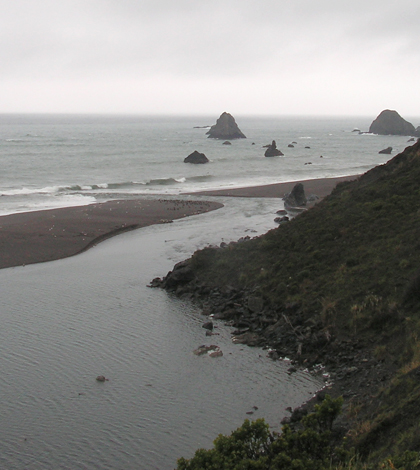Abandoned, buried jetty’s effects on Russian River Estuary studied

The Russian River where it flows into the Pacific Ocean (Credit: Wouter Kiel, via Flickr)
Constructed in the early 1930s, the jetty at California’s Goat Rock Beach State Park was designed to keep the mouth of the Russian River open for shipping. Two decades spent reinforcing the structure proved futile as the river mouth closed again and again. Eventually the construction companies abandoned the jetty, and left it to disappear beneath the sands that now cover it.
In 2008, the National Marine Fishery Service issued the Russian River Biological Opinion, requiring the Sonoma County Water Agency to study the historic structure and its effects on ocean and river processes around the estuary.
“That document… lays out an adaptive management plan for the estuary,” said Chris Delaney, senior engineer at the agency. “It establishes requirements in order to improve estuary habitat and create a freshwater lagoon habitat.”
The study began in earnest in 2011, when researchers assessed construction manifests and blueprints to learn how, and with what materials, the jetty was built.
Researchers began mapping the jetty in March 2014. To see details of the hidden structure, subcontracted specialists from Lawrence Berkeley National Laboratory and NorCal Geophysical conducted analyses with electrical resistance tomography, ground penetrating radar and electromagnetic monitoring.
“They’re using these electrical instruments and looking at the electrical properties of the material beneath their feet underground to ascertain the composition and levels of seepage through the estuary,” Delaney said.

A section of the jetty exposed near the mouth of the Russian River Estuary (Credit: Naotake Murayama, via Flickr)
Understanding water seeps through the structure and the beaches around it is important in fulfilling one of the study’s primary goals: completing a system water balance analysis.
Five monitoring wells have already been installed to quantify water flow into the estuary with stream gauges. Once fully instrumented, the wells will feature electrical conductivity meters, temperature probes and pressure transducers.
“Using those known inputs, we can roughly calculate what’s leaving the estuary,” Delaney said.
The study will also assess ocean waves and inlet and beach morphology. That will give researchers a better understanding of how the beach configuration affects waves, and how those waves in turn shape the beach.Information gleaned from the assessments may help guide alternative jetty designs.
The final phase of the Russian River study will examine future options for the jetty, such as removing or modifying the structure to improve the estuary. However, no funds are currently allocated for renovations.
“The biological opinion does not require us to fund the removal or modification of the jetty — just to do this study,” Delaney said. Speculating, he added: “If there are substantial alternatives that could greatly benefit habitat, then there could be some grant opportunities to be pursued.”
The study will continue for eight months, though research at the beach will be restricted until July to accommodate for seal pupping season.
Top image: The Russian River where it flows into the Pacific Ocean (Credit: Wouter Kiel, via Flickr)





0 comments